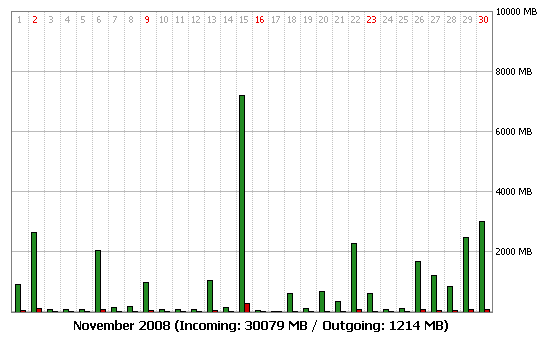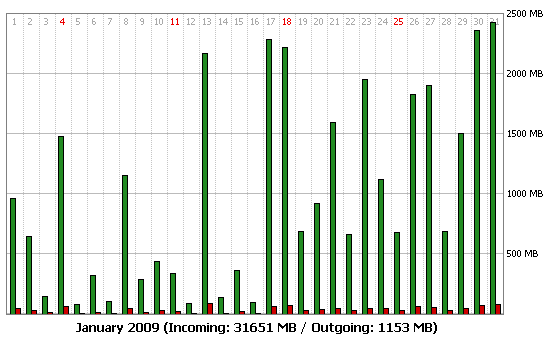Time Warner Cable recently announced that it will be bringing bandwidth caps to more cities, after apparent success in their trial area of Beaumont, Texas. The upper bound on the cap is 40 GB, considerably lower than the 250 GB cap used by Comcast. Go over that amount, and TWC will charge you extra overage fees. I'm completely against this. If caps come to our area, I will seriously consider ditching TWC for some other means of internet access (perhaps the recently mentioned WISP network). Note to Verizon: start rolling out your FiOS service to the Triangle area; I will happily subscribe!
Anyways, while chatting with my dad about these caps, we got wondering about what our bandwidth usage rates really are. I recalled that my router (the oh-so-wonderful Linksys WRT54GL), which I flashed with the open-source DD-WRT firmware, supports bandwidth monitoring (beginning in v24). Happily, I flashed v24-SP1 right before I moved into my new house, so the data has been collecting ever since that time. There are some very interesting trends in the graphs, so let's take a look at them:

I moved in on September 30, so October of last year is the first month I had data for. As you can see, I transferred just under 31 GB for the entire month. Though it's not as apparent on this graph, the peak daily value was 4204 MB. One interesting trend in this graph is that you can see how busy I was with unpacking my stuff at the beginning of the month. As the month went on, I was online more and more.

The graph for November is a little misleading. Note that the units on the y-axis are on a different scale. This is thanks to the largest daily transfer (a clear outlier): 7223 MB on November 15. I purchased a game on Steam that day, which accounts for the majority of that bandwidth. Overall, this month was pretty light, though you can see that I was home at the end of the month (for the Thanksgiving holiday). November's bandwidth total was just over 30 GB.

I was home for over half of December, thanks to all the vacation I failed to take throughout 2008. As such, my daily bandwidth average was much higher, with a monthly total of 34.6 GB. I was out of town from the 27th to the 31st, which explains the lull in that period. The largest daily total was 4780 MB, on December 15.

January's graph is very interesting. Again, take note that the y-axis values are different. Can you identify the day I received my Roku player? It's pretty clear that January 17th is the beginning of a new trend of bandwidth. I've been watching a bunch of stuff on Netflix watch instantly, which accounts for the daily spike in activity. The monthly total for January was 31.6 GB, with the largest daily peak of 2428 MB occurring on January 31.
All in all, these graphs are pretty interesting to analyze. Watching my bandwidth usage over the next few months should be an educational experience. Surprisingly, I have yet to break the theoretical 40 GB limit. However, I have not yet had my Roku player for a whole calendar month. After February has come to a close, I will post an update on my bandwidth usage. That should give me a better clue as to what my 'real' bandwidth totals will be going forward, seeing as I watch Netflix content more than I watch broadcast TV.
Do you track your bandwidth? If so, share your findings!